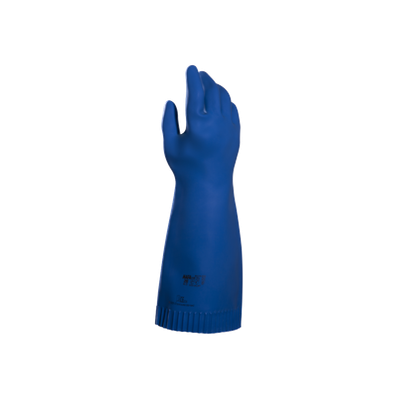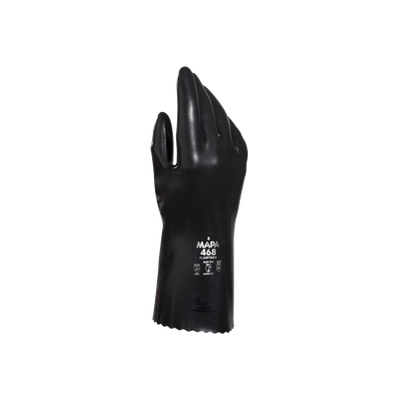Ultranitril 491
Good mechanical resistance and long-lasting chemical protection
-
CAT. 3
 0334
0334
-
 3101X
3101X
-
Type A
 AJKOPT
AJKOPT
-
 VIRUS
VIRUS
-

Specific advantages
 Comfort
Comfort
- Dexterity and comfort, due to the anatomical shape and the quality of the flock-lining
 Durability
Durability
- Longer service life: excellent mechanical resistance (abrasion, perforation)
 Guaranteed quality
Guaranteed quality
- Silicone free to prevent traces, defects on metal sheet and glass prior to painting
Applications
Automotive/mechanical industry
- Machining parts using cutting oil
- Treating/degreasing metals with solvents
Chemical industry
- Manufacture and application of paints and varnishes
Other industries
- Application of pesticides
- Cleaning of printing-press rollers
- Maintenance
- Timber treatment and finishing
Agriculture sector
- Spray mixtures preparation
- Pesticides handling
- Tank filling
- Application & spreading of pesticides
- Pesticides waste management
- Treatment equipment cleaning
Product detail
| Material | Nitrile |
|---|---|
| Colour | green |
| Interior finish | Flocked |
| Exterior finish | Embossed texture |
| Length (cm) | 37 |
| Thickness (mm) | 0.38 |
| Size | 6 7 8 9 10 |
| Packaging | 10 pairs/bag 50 pairs/carton |
Chemical chart
OVERALL CHEMICAL PROTECTION RATING
Protection rating is determined by taking into account the effects of both permeation and degradation in an attempt to provide users with an overall protection guideline when using our glove products against specific chemicals.
Meaning of the colours :
The chemical test data and overall chemical protection rating should not be used as the absolute basis for glove selection. Actual in-use conditions may vary glove performance from the controlled conditions of laboratory tests. Factors other than chemical contact time
| Chemical Product | CAS # | Breakthrough time (minutes) |
Permeation level |
Standard | Degradation level |
Rating |
|---|---|---|---|---|---|---|
| 1,1,1-Trichloroethane 99% | 71-55-6 | 45 | 2 | EN 374-3:2003 | 1 |
|
| 2-Butoxyethanol (Butyl Cellusolve) 99% | 111-76-2 | 236 | 4 | EN 374-3:2003 | 3 |
|
| 2-Propanol (Isopropanol) 99% | 67-63-0 | >360 | 5 | EN 374-3:2003 | 3 |
|
| Acetic acid 99% | 64-19-7 | 47 | 2 | EN 374-3:2003 | 1 |
|
| Acetone 99% | 67-64-1 | 3 | 0 | EN 374-3:2003 | 1 |
|
| Ammonium hydroxide solution 25% | 1336-21-6 | 132 | 4 | EN 16523-1:2015 | 4 |
|
| Bromine 100% | 7726-95-6 | 18 | 1 | EN 374-3:2003 | NT |
|
| Bromobenzene 99% | 108-86-1 | 9 | 0 | EN 374-3:2003 | NT |
|
| Butyl Acetate 99% | 123-86-4 | 25 | 1 | EN 374-3:2003 | 1 |
|
| Carbon disulfide 99% | 75-15-0 | 3 | 0 | EN 16523-1:2015 | NT |
|
| Cyclohexane 99% | 110-82-7 | >480 | 6 | EN 374-3:2003 | 4 |
|
| Cyclohexanone 99% | 108-94-1 | 29 | 1 | EN 374-3:2003 | 1 |
|
| Dichloromethane (Methylene Chloride) 99% | 75-09-2 | <1 | 0 | EN 374-3:2003 | 1 |
|
| Diethylamine 98% | 109-89-7 | 17 | 1 | EN 374-3:2003 | 1 |
|
| Dimethylsulfoxide 99% | 67-68-5 | 47 | 2 | EN 374-3:2003 | 1 |
|
| Ethanol 95% | 64-17-5 | 130 | 4 | EN 374-3:2003 | 3 |
|
| Formaldehyde 37% | 50-00-0 | >480 | 6 | EN 16523-1:2015 | 4 |
|
| Fuel oils mixture | 68476-34-6 | >480 | 6 | EN 374-3:2003 | 4 |
|
| Hydrogen peroxide 30% | 7722-84-1 | >480 | 6 | EN 16523-1:2015 | 3 |
|
| Methanol 99% | 67-56-1 | 47 | 2 | EN 16523-1:2015 | 1 |
|
| Methyl Ethyl Ketone (2-Butanone) 99% | 78-93-3 | 5 | 0 | EN 374-3:2003 | 1 |
|
| Methyl methacrylate 95% | 80-62-6 | 11 | 1 | EN 374-3:2003 | 1 |
|
| Methylisobutylketone 99% | 108-10-1 | 15 | 1 | EN 374-3:2003 | 1 |
|
| n-Heptane 99% | 142-82-5 | >480 | 6 | EN 16523-1:2015 | 4 |
|
| N-methyl-2-Pyrrolidone 99% | 872-50-4 | 35 | 2 | EN 374-3:2003 | 1 |
|
| N-N dimethyl acetamide 99% | 127-19-5 | 10 | 0 | EN 374-3:2003 | 1 |
|
| Naphtha, Hydrodesulphurized Heavy mixture | 64742-82-1 | >480 | 6 | EN 374-3:2003 | 4 |
|
| Naphtha, Hydrotreated Heavy mixture | 64742-48-9 | >480 | 6 | EN 374-3:2003 | 4 |
|
| Pentane isomers mixture | NA | >480 | 6 | EN 374-3:2003 | NT |
|
| Phosphoric acid 75% | 7664-38-2 | >480 | 6 | EN 374-3:2003 | 4 |
|
| Sodium hydroxide 20% | 1310-73-2 | >480 | 6 | EN 374-3:2003 | 4 |
|
| Sodium hydroxide 40% | 1310-73-2 | >480 | 6 | EN 16523-1:2015 | 4 |
|
| Sodium hydroxide 50% | 1310-73-2 | >480 | 6 | EN 374-3:2003 | 4 |
|
| Styrene 99% | 100-42-5 | 9 | 0 | EN 374-3:2003 | 1 |
|
| Sulfuric acid 96% | 7664-93-9 | 80 | 3 | EN 374-3:2003 | 1 |
|
| t-Butyl Methyl Ether 98% | 1634-04-4 | 240 | 4 | EN 374-3:2003 | 3 |
|
| Tetrachloroethylene (Perchloroethylene) 99% | 127-18-4 | 117 | 3 | EN 374-3:2003 | 3 |
|
| Tetrahydrofurane 99% | 109-99-9 | 4 | 0 | EN 374-3:2003 | 1 |
|
| Toluene 99% | 108-88-3 | 16 | 1 | EN 374-3:2003 | 1 |
|
| Trichloroethylene 99% | 79-01-6 | 4 | 0 | EN 374-3:2003 | 1 |
|
| Unleaded gasoline mixture | 8006-61-9 | 98 | 3 | EN 374-3:2003 | 4 |
|
| Vinyl acetate 99% | 108-05-4 | 9 | 0 | EN 374-3:2003 | 1 |
|
| Xylene 99% | 1330-20-7 | 33 | 1 | EN 374-3:2003 | 1 |
|
*not normalized result







